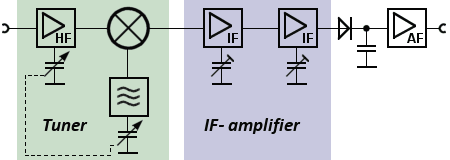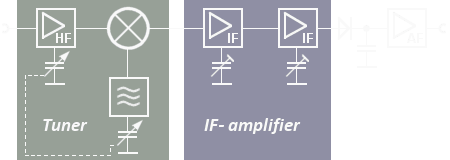Let's made a Superheterodyne!


To create low frequency information from a RF-signal, the received signal has to be demodulated. However, the received RF-signal is extremely weak and the diode needs a certain minimum value to function. (For this reason this type of receiver can only be used close to very large transmitters.)


For this reason a HF- preamplifier, which lowers the minimum discernible signal even further and extends the range, is used. To be able to amplify only the needed frequency the pre-amplifier has to have a very narrow bandwith.


This only allowes us to receive one frequency. Rather limited! Therefore we'll make the RF pre-amplifier tuneable with e.g. a variable capacitor.


Still not really sufficient. We need more amplification.
We don't want to turn two buttons at the same time and thus these two need to be
connected mechanically (so-called: “ganged capacitors”).
Be carefully! All amplifiers need to be well insulated!
In case of high frequency installations every larger wire becomes a transmitting antenna.
Then the transmitted energy is received again by our receiving antenna and the whole
system begins to oscillate. As a result the sensitive receiver becomes a strong transmitter!
Theoretically this can be extended until...


... the tuning mechanics fail and feedback occurs again!
If we abandon tuneability, the following circuit would be possible:


What a pity! We can only receive one frequency but the receiver is very sensitive to it.
What happens if we tune the “One-Frequency-Receiver” into a frequency which is not particularly active and at the same time install a tunable converter, whose output frequency as a difference between the received frequency and the tunable oscillator frequency remains constant?...


... in that case we invented a Superheterodyne!!!
The Super Heterodyne receiver (or to give it its full name, The Supersonic Heterodyne Receiver) was invented by Edwin Armstrong in 1918.
